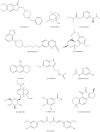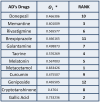Regression analysis of topological indices for predicting efficacy of Alzheimer's drugs
- PMID: 39485746
- PMCID: PMC11530053
- DOI: 10.1371/journal.pone.0309477
Regression analysis of topological indices for predicting efficacy of Alzheimer's drugs
Abstract
Alzheimer's Disease(AD) is the most common type of dementia. It is a progressive disease beginning with mild memory loss and possibly leading to loss of the ability to carry on a conversation and respond to the environment. This study investigates the relationship between the chemical structure of potential AD drugs and their therapeutic efficacy using Multi-Criteria Decision-Making (MCDM) techniques including The approach for Order Preference by Similarity to Ideal Solution (TOPSIS) and Simple Additive Weighting (SAW) method. A comprehensive dataset comprising molecular descriptors and corresponding pharmacological properties, i.e., melting point, boiling point, molecular weight and density of AD drugs was compiled from diverse sources. Topological indices were calculated to capture the structural characteristics of these compounds. Application of TOPSIS and SAW through Entropy method helps obtain optimal drugs for curing AD. Quantitative Structure Property Relationships (QSPR) analysis has been done between properties and topological indices of AD's drug structures. Results revealed significant relations between specific topological indices and drug efficacy, providing insights into the structural features crucial for AD treatment efficacy. This approach offers a promising avenue for rational drug design and optimization in the quest for novel AD therapeutics.
Copyright: © 2024 Ashraf et al. This is an open access article distributed under the terms of the Creative Commons Attribution License, which permits unrestricted use, distribution, and reproduction in any medium, provided the original author and source are credited.
Conflict of interest statement
The authors have declared that no competing interests exist.
Figures













Similar articles
-
Physicochemical profiling and ranking of parkinson's disease drugs through QSPR and Fuzzy TOPSIS analysis.Sci Rep. 2025 May 3;15(1):15527. doi: 10.1038/s41598-025-99583-8. Sci Rep. 2025. PMID: 40319101 Free PMC article.
-
QSPR analysis of physico-chemical and pharmacological properties of medications for Parkinson's treatment utilizing neighborhood degree-based topological descriptors.Sci Rep. 2025 May 15;15(1):16941. doi: 10.1038/s41598-025-00898-3. Sci Rep. 2025. PMID: 40374678 Free PMC article.
-
A computational approach to drug design for multiple sclerosis via QSPR modeling, chemical graph theory, and multi-criteria decision analysis.BMC Chem. 2025 Jan 2;19(1):1. doi: 10.1186/s13065-024-01374-1. BMC Chem. 2025. PMID: 39748369 Free PMC article.
-
Chemical graphs, molecular matrices and topological indices in chemoinformatics and quantitative structure-activity relationships.Curr Comput Aided Drug Des. 2013 Jun;9(2):153-63. doi: 10.2174/1573409911309020002. Curr Comput Aided Drug Des. 2013. PMID: 23701000 Review.
-
Innovative approaches in QSPR modelling using topological indices for the development of cancer treatments.PLoS One. 2025 Feb 21;20(2):e0317507. doi: 10.1371/journal.pone.0317507. eCollection 2025. PLoS One. 2025. PMID: 39982891 Free PMC article. Review.
Cited by
-
The role of ferroptosis in Alzheimer's disease: Mechanisms and therapeutic potential (Review).Mol Med Rep. 2025 Jul;32(1):192. doi: 10.3892/mmr.2025.13557. Epub 2025 May 9. Mol Med Rep. 2025. PMID: 40341407 Free PMC article. Review.
-
QSPR analysis of amino acids for the family of Gourava indices.PLoS One. 2025 Apr 29;20(4):e0319029. doi: 10.1371/journal.pone.0319029. eCollection 2025. PLoS One. 2025. PMID: 40300030 Free PMC article.
References
-
- Alzheimer’s Association. (2022). Alzheimer’s disease facts and figures. Alzheimer’s and Dementia, 18(1), e1–e98. - PubMed
-
- Todeschini, R., Consonni, V. (2000). Handbook of molecular descriptors. Wiley-VCH.
-
- Roy K., Mitra I., and Kar S. (2015). Topological descriptors in drug discovery and development. Progress in Biophysics and Molecular Biology, 118(1-2), 22–43.
MeSH terms
LinkOut - more resources
Full Text Sources
Medical

